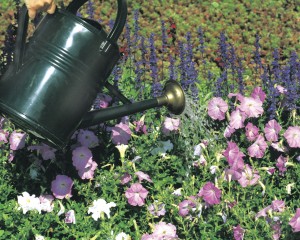Watering properly is key to healthy plants — and conservation
July 12, 2017We’ve been fortunate this summer — so far — with a fair amount of rain that’s been keeping lawns green and gardens growing. Still, there are times when plants need a little more than Mother Nature is providing.
We’ve blogged many times about using rain barrels to help conserve water, but watering properly also helps our water supply. What’s more, it’s also better for your plants than just spraying them down with the hose any old time of the day.

A recent article from Rodale’s Organic Life had some great advice — and revealed a few surprising findings, too.
“A study published in the journal New Phytologist found that, in some cases, watering plants in the heat of the day can do more harm than good,” the article says. It also cited Hungarian researchers who “studied sunlit water droplets on leaves with different types of surfaces, and they found that on leaves that have “plant hairs” (think tomatoes, cucumbers, pumpkins), water droplets essentially act like magnifying glasses, intensifying damage caused by the sun—basically it’s easier for the plant to get sunburned when it’s wet. Plants with smooth leaves, such as maple tree leaves or ginkgo tree leaves don’t suffer the same fate.”
So, what’s the secret to happy, healthy plants? Here’s a mix of tips:
USDA Guidelines
- One deep watering is much better than watering several times lightly.
- Lawns need about 1 inch of water each week. If the weather is very hot, apply an inch of water about every 3 days.
- Watering to a depth of 4-6 inches encourages deeper, healthier root development. It allows longer periods between watering.
- To measure the water, put an empty tuna can (or cat food can) on the lawn while watering. Stop watering when the can is full or if you notice water running off the lawn.
Know Your Soil
Different soil types have different watering needs. You don’t need to be a soil scientist to know how to water your soil properly. These tips can help. - Loosen the soil around plants so it can quickly absorb water and nutrients.
- Use a 1- to 2-inch protective layer of mulch on the soil surface above the root area. Cultivating and mulching reduce evaporation and soil erosion.
- Clay soil: Add organic material such as compost or peat moss. Till or spade to help loosen the soil. Since clay soil absorbs water very slowly, water only as fast as the soil absorbs the water.
- Sandy soil: Add organic material to supplement sandy soil. Otherwise, the water can run through it so quickly that plants won’t be able to absorb it.
- Loam soil: The best kind of soil. It’s a combination of sand, silt, and clay. Loam absorbs water readily and stores it for plants to use.
Water at the Right Time of the Day - Early morning or night is the best time for watering to reduce evaporation.
- To help control where your water goes, water when it’s not windy.
Rodale’s Advice:
- Don’t water in the afternoon. The threat of sunburn is not the only reason to avoid watering when the sun is high—midday is never an ideal time to water plants no matter what type of leaf structure they have.
- The best time to water plants is in the morning, between dawn and mid-morning, before the sun gets to be too hot. Don’t water after dark, though, since the overnight moisture could promote the growth of fungus.”
- Water deeply and infrequently if you can. Watering plants for several hours with a soaker hose drip irrigation system once a week beats anything else.
- Avoid getting the leaves wet as that can lead to fungal infections. Your goal is to create soil that’s damp but not soggy down to five to six inches below the surface. To figure out if your garden needs watering, simply push your finger into the soil surrounding your plants. You want the top two or three inches of the soil to be dry, with the soil below that moist.